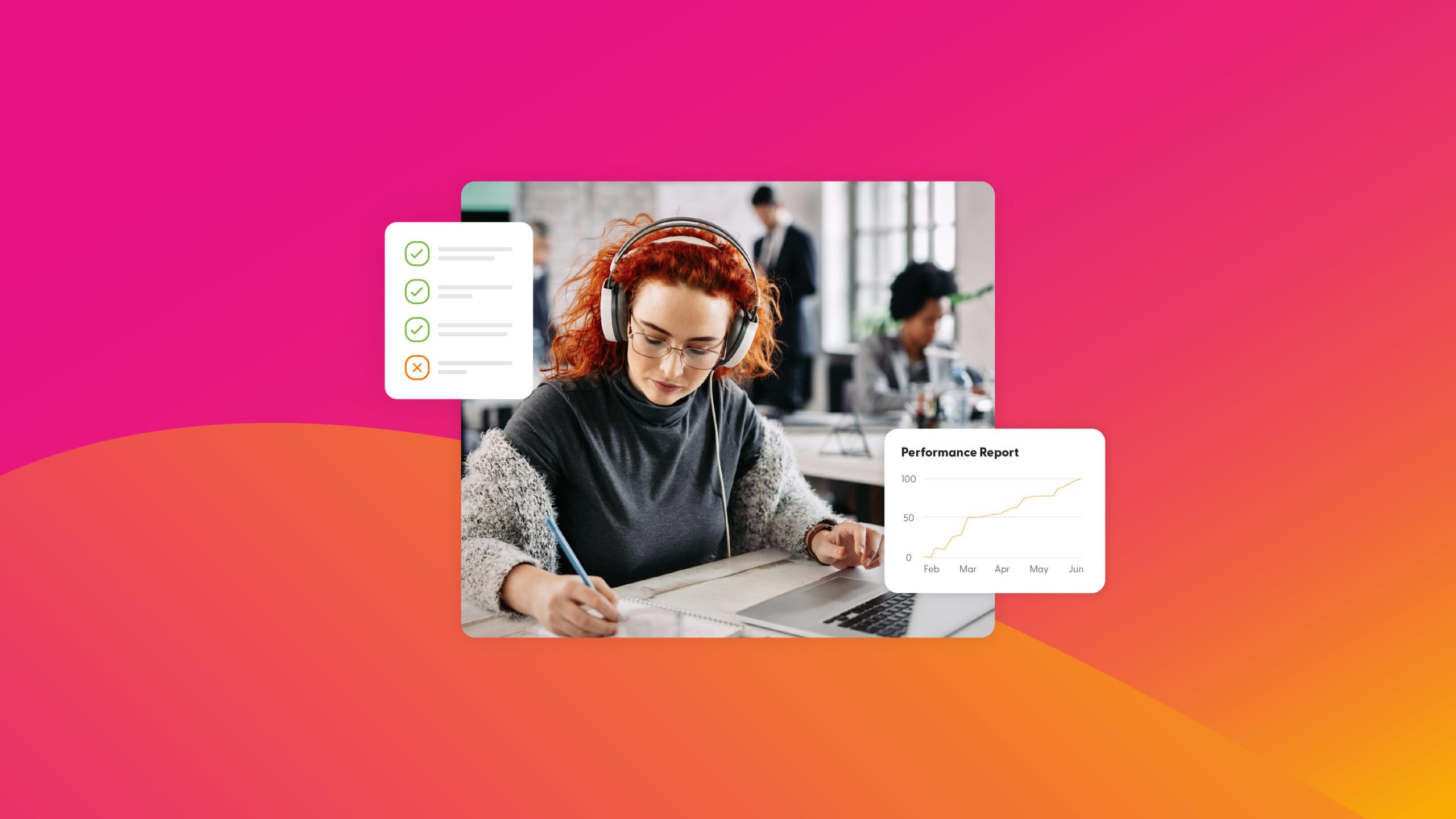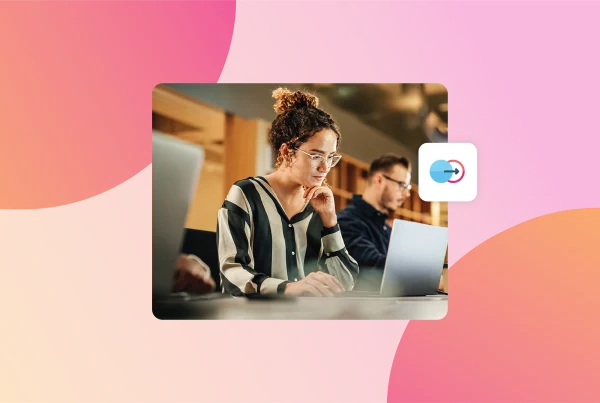It should come as little surprise to anyone that a well-educated, highly skilled, and motivated workforce is paramount to operational success.⚡️
This means that integrating robust L&D that’s agile, flexible and consistently meets business demands will propel organisations to new heights.
Yet, in today’s demanding, fast-paced, and often time-sensitive commercial ecosystem, this can be a challenge.
What’s apparent is that making learning and development more accessible is important, especially when shrewd time management is so important.
Many organisations view time as one of, if not the, biggest barriers to learning and development. After all, employee time spent on anything other than core business tasks will affect workflows.
This is why understanding what the learning flow of work is, how it affects productivity, and what you can do to optimise it is something that every organisation must address.
Want to learn how you can highlight operational inefficiencies, integrate much-needed L&D into existing workflows, and improve performance?
Here’s the essential information you need to know about learning in the flow of work.👇
What is learning in the flow of work?
Learning in the flow of work provides employees with the content and information they need to complete each task, exactly when they need it.
Imagine that the business is rolling out a new internal CRM. Everyone knows and can use the legacy software, but this new CRM… Not so much. The leadership team wants to minimise disruption.
Everyone in the organisation needs to get up to speed as quickly as possible. But that doesn’t mean that essential tasks can be neglected. 🖥️
Do you cease operations and pull everyone out for a week-long, three-day, or even an 8-hour training course? No. You initiate a learning flow at work model.
Make the learning process a natural part of people’s everyday jobs, and it will minimise day-to-day disruptions. Best of all, this L&D model doesn’t actually feel like learning, more like it’s natural, just an extension of an employee’s day-to-day commitments. 💭
It’s not about providing employee training, even blended learning; it’s about creating a structure of readily available, accessible information that everyone can leverage at the exact time they need it.
Think about training courses. They’re essential.
Give people greater purpose. Make them assets that can help transform organisations in the long term.
That’s great!
But how often is every single aspect of that training forgotten six, three, or even a month after the training has been completed?
Then there’s the fact that colleagues would likely have to sift through hours of training literature to find the information they need to complete a task at that time. Sounds inefficient, right?
Learning in the flow of work, in essence, hardwires people’s brains to think and act more efficiently while being equipped with the knowledge and experience to excel in their roles.
Why is learning in the flow of work important?
The importance of learning in the flow of work has grown in the wake of a lack of training software that meets the evolving needs of the modern working environment.
Once considered to be at the forefront of L&D, many legacy Learning Management Systems (LMS) struggle to keep up with the contemporary fluidity, accessibility, and functionality needed to fully optimise any workforce’s productivity. 📈
At best, LMS can be considered clunky or outdated. At worst, LMS pulls workforces away from the day-to-day for hours or even days at a time. This has an obvious effect on the performance of individuals, teams, and organisations as a whole.
Now consider the sheer proliferation of remote and hybrid work since the pandemic.
In the UK alone, as much as 56% of the workforce operates in a remote or hybrid environment. In fact, since 2010, remote working has increased by 159%.
Organisations simply do not have the time nor the infrastructure to implement robust legacy learning that meets the evolving needs of the organisation.
By implementing learning into the flow of work, training and development are more effective.
People can immediately apply what they’ve learned. Experiencing this impact in real time builds confidence and competence. This improves organisational operations and performance and, when executed well, will stimulate growth.
Learning in the flow of work examples in the real world
Let’s have a look at how you can leverage learning in the flow of work using Learning Management Systems (LMS) in the real world to promote a seamless, engaging, and effective L&D experience.
Using past behaviour to recommend future
The most obvious example of this is found in the digital space. YouTube, Netflix, Amazon, and Spotify have long used recommendations to keep audiences engaged with their content.
By providing choices based on relevant behaviour, businesses meet the needs of their customers and staff by accurately anticipating their needs. 👍
In L&D, data can inform actions. Let’s say, for example, that team members have undertaken a series of safety and compliance courses. But the qualifications attained are out of date. Knowing this, recommendations to update learning can be communicated.
This allows people to always complete any required courses needed to perform their role at the right time to guarantee seamless operations.
Optimise content accessibility
If L&D thought leaders want to optimise the process, they should make access to helpful resources readily available in the blink of an eye.
It’s pretty much a no-brainer, but sharing access to whitepapers, blogs, and articles, even including search filters to help people find and access the content they need when they need it, is essential.
Use a knowledge bookmark
Building on the ‘accessibility’ of resources, tools like Knowledge Mark can streamline the time it takes to identify and share resources.
This tool allows users to add external site information to their resource pool. Simply integrate the tool into your bookmarks, find the external site you wish to upload, and click the Knowledge Mark bookmark. Doing this allows users to track content accessed outside of the LMS and seamlessly integrate it without having to navigate from the page or switch browsers.💡
Leverage chatbots and AI language learning models.
Let’s say you’re doing research for an upcoming L&D project that you hope will help you optimise your workflows and productivity.
Asking the right questions and getting the precise answer at the right time to add real value to the L&D experience will save an awful lot of time!
Talking to people, sending emails, and waiting for a reply both take time. Both chatbots and AI can deliver answers in seconds.🦾
A word of caution, though: AI applications like ChatGPT and Google Bard may have experienced huge growth throughout 2023, but the technology is still in its infancy. If you’re unsure of whether their answers are accurate or helpful, don’t be afraid to question them!
The Benefits of Learning in the Flow of Work
Below are just some of the benefits of learning in the flow of work. Some we’ve mentioned throughout this blog, but there’s absolutely no need for dispute. 👇 👇
Contextual relevance
People learn better when new information is put into context. The brain learns to recognise key aspects of a process. More than that, people also learn how to adapt knowledge and skills to specific situations. 👍
Improved retention
Not only does relevant L&D training improve engagement—in some cases by 300%—but it also results in improved retention. Don’t believe us? A 2019 Harvard study found that active learning is much more effective than passive learning.
So, the next time you think about investing in employees by giving them reams and reams of literature to absorb or sending them to seminar after seminar, stop and consider if learning in the flow of work wouldn’t be a better approach. 👍
Enhanced efficiency
Allowing your workforce to access learning content as and when they need it bolsters the learning experience. It also means less time spent in training and more time contextualising and applying theoretical knowledge. According to statistics, this alone results in an 8% rise in productivity and an additional 720 working hours, the equivalent of 30 days!
Continuous learning
To become proficient, a thought leader, and authority, businesses need to invest in continuous learning.
This means employees and organisations get better and better at what they do. Realistically, the most efficient way of doing this is through simultaneous learning and working, implementing new strategies, processes, and actions in real time. 📚 📚
Personalised learning
People learn and retain more when L&D is tailored to them.
Why?
Personalised learning increases engagement and motivation, improves knowledge retention rates, promotes motivation and accountability through ownership, and leverages resources wisely.
Seamless integration of technology
Leveraging the right L&D platform will improve learning in the flow of work experience by reinforcing knowledge through practical application.
Better still, the right platform will improve the process by allowing learners to perform their roles while learning.
Agility and adaptability
The last core benefit of learning in the flow of work is its agility and adaptability.
How?
The process promotes easy scalability and learning as and when required. This allows businesses to scale operations without any concerted planning that could disrupt productivity. 😄
In summary
The bottom line is that if you want to upskill your workforce to better meet the evolving needs of your clients and are considering what L&D process to use, you’d be hard-pressed to find a better one than learning in the flow of work.
But you don’t have to take our word for it. Oracle, SAP, and Workday all leverage learning in the flow of work to broaden the skillsets of their employees.
Will you do the same?
Close any knowledge and skill gaps with Thirst
The Thirst AI-powered learning platform empowers L&D professionals to accelerate their learning culture, talent acquisition, leadership development, and internal mobility. It’s your chance to close your skills gap—fast. 🙂
Interested in learning more? Book a demo today. 👍
For more e-learning insights, resources and information, discover the Thirst blog.
You may also enjoy:
What Is Social Learning Theory, and Why Is It Important? | How to Create a Great Leadership Development Plan in 2023 | 7 Ways to Identify Knowledge & Skills Gaps in Your Workforce






